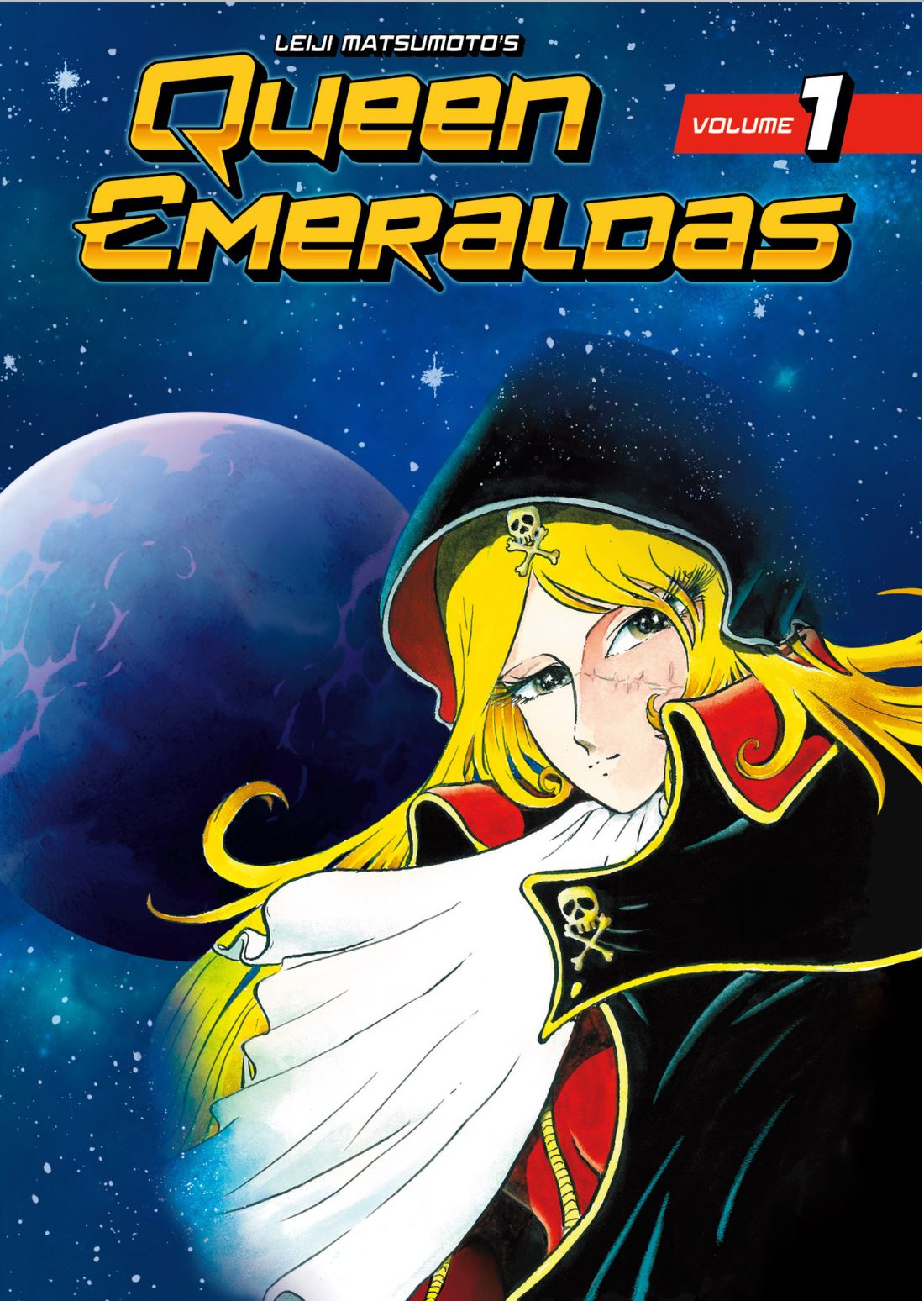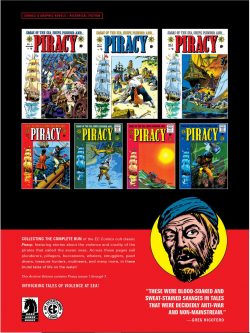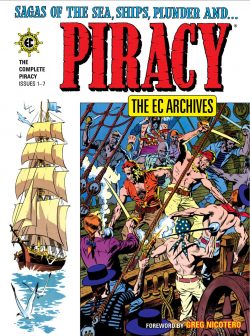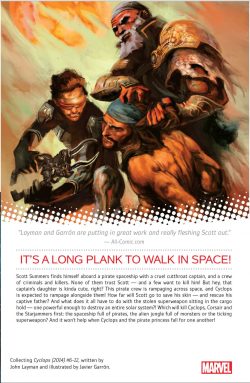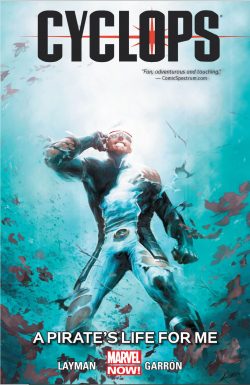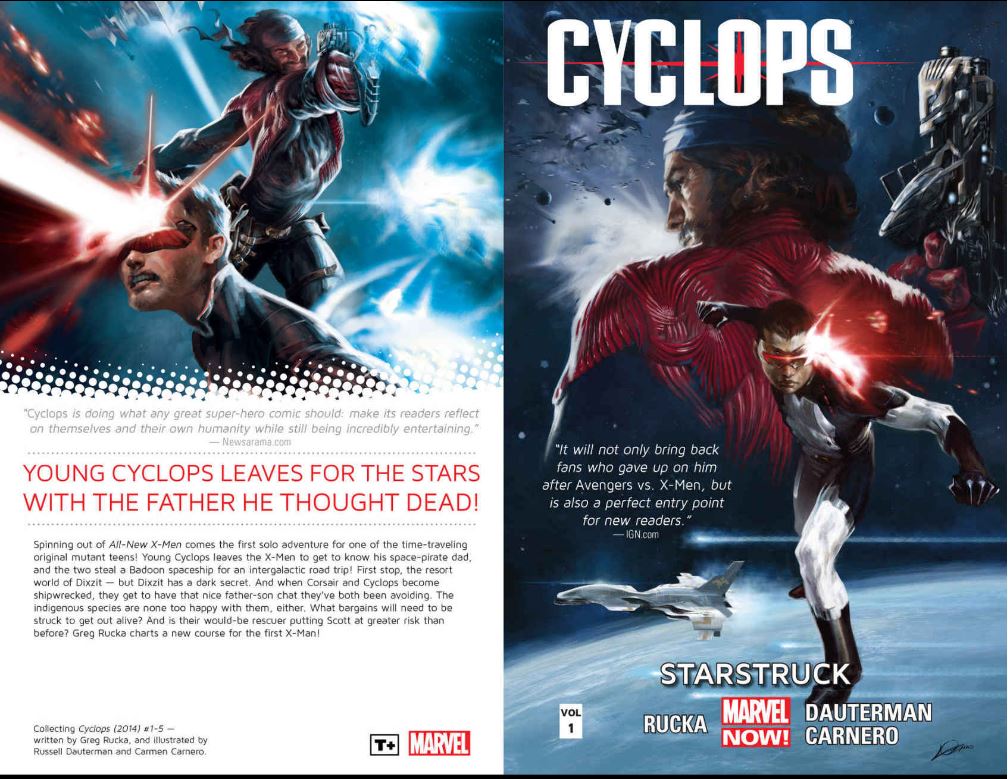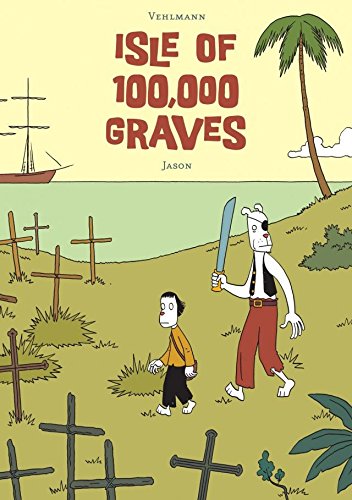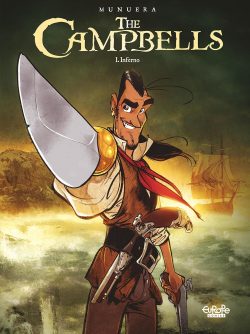
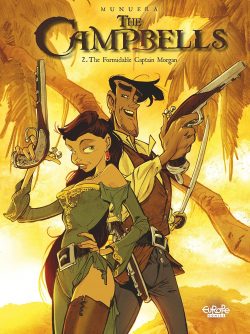
By José Luis Munuera, coloured by Sedyas translated by Emma Wilson (Europe Comics)
Digital Editions – No ISBNs:
Arrr an’ Wot Ho! It be anuvver International Talk Like a Pirate Day once morrrre, me Hearties! That gives me license to act like a complete berk whilst plugging a suitably themed graphic yarn. This ‘un be a real cracker, too…
As heavily influenced by a certain Disney movie franchise as continental Europe’s long-standing affection for the genre, and exhibiting a deft hand with the traditions and history of light-hearted freebooting romps, Inferno is the introductory salvo in a convoluted yet engaging family saga about a most unconventional bunch of buccaneers.
Crafted by Andalusian comics veteran José Luis Munuera (No Hay Domingos en el Infierno, Merlin, Walter le Loup, Spirou et Fantasio, P’tit Boule et Bill) who has been delighting readers since his debut in 1996, the epic voyage of discovery commences here with smart, snappy episodes introducing an extremely large cast of roguish characters. First up are devious rapscallion “Captain” Carapepino and his trusty dogsbody Haggins. A very minor player with huge aspirations, this smooth talker is off burying his first chest of treasure on a sun-kissed tropical island when he is ambushed and hijacked by the infamous – and long-missing – Captain Campbell.
Through a most cunning ploy, the pirate’s pirate (with two young daughters at his side) appropriates the gem-strewn chest and smugly paddles away to another paradisiacal atoll…
The next vignette sees the wonder family man at ease in his luxurious haven on Garden Island, patiently watching teenaged Itaca explode again as her obnoxiously bratty sister Genova reads excerpts from someone’s secret – stolen – diary…
Despite always acting out and indulging in outrageous feats of derring-do, the well-educated, ultra-fit kids love each other and desperately miss their mother.
Out in the briny depths, formidably ferocious Captain Inferno terrorises victims and his own men. A man of dark moods and soaring ambition, he is haunted by visions of a dead woman who comes to him often, repeating three horrifying predictions that he cannot escape. His night terrors are suppressed but not abated by the arrival of unctuous Carapepino who shares that encounter with the sea terror’s most despised enemy… and husband of the ghost who plagues him!
The Campbells might be sea-wolves but they are most unconventional ones. Amongst those who love them most are the inhabitants of the Isle of Bakaloo: a leper colony the family regularly visit with supplies of food, books and other life-easing essentials. On this latest jaunt, the canny corsairs bring along the latest chest of valuables: after all, what normal, superstitious rogues would risk their scurvy skins amongst the unclean and diseased?
Some days later, the family visit fiercely neutral township Bahia Cambalanche, Port Franc. Here all hawks of the seas can meet to trade, carouse and fence their stolen booty. Here and now, Itaca and Genova reluctantly attend lessons arranged by their father.
Right here, right now, Carapepino and a press gang provided by Inferno attempt to abduct the girls only to be beaten back by their unbridled fury and the late intervention of gorgeous teenager Blond Luca. Itaca is instantly smitten by the glorious hero, blithely unaware that her saviour is a pawn in a dastardly long con…
The deception blossoms soon after as Garden Island is invaded by Carapepino’s borrowed forces. Nevertheless, the trio of Campbells fight free, humiliate the craven dogs and make a bold escape to a new sanctuary. In the interim, Inferno has not been idle. By ruthless manipulation and scurrilous deals, he has ingratiated himself with English nobility – and Campbell’s oldest enemies – in order to have himself admitted to the top flight of the corrupt aristocracy. Invested as Baron of England, with a warrant to hunt all shipping but British vessels, Inferno moves quickly to consolidate power and replace the crown’s agents with his own people…
The Campbells have relocated to Bakeloo Island where Itaca broods over Luca’s betrayal as her father worries about her unexplained distress. Father is also blithely oblivious to passionate and sustained adoration of indigenous lovely Nutel-La, but the practical islander finally makes a big impression by suggesting that the devoted dad needs to have “the talk” with his manifestly-maturing older daughter…
Having lost yet another ship, Carapepino and his surviving crew at last link up with former employer Baron Inferno, just in time to become his first detainees as the freshly ennobled provincial ruler moves into his new Governor’s Palace.
The interloper eases gracefully to the head of the aristocratic pack, gleaming in fine clothes, sparkling with newfound power and respectability. After all, aren’t these rich privileged fools just another gang of self-proclaimed predators? Especially shockingly blunt and ruthlessly amoral Lady Helvetia, who becomes his boon companion and more…
When the revels end, the Baron’s mind races back decades to the docks of London where he and his bold, inventive, loyal brother picked pockets and sought to escape their monster of a father. How far they have come since then. How far they have drifted apart…
To Be Continued…
Volume 2: The Formidable Captain Morgan
The seagoing saga resumes with more revelations as 2017’s Les Campbell – 2. Le redoutable pirate Morgan arrives to further the fun-filled furore. As Itaca and Genova find fresh ways to perk up their sisterly rivalry, the younger girl asks about the mother she doesn’t remember. That tricky conversation sparks a flashback to when the bold Campbell brothers first tried to recruit a band of cutthroats to serve under them…
Elsewhere, Dad is having similar reveries of the mere slip of girl he met one day and how Nancy was the most capable streetfighter he had ever seen. Sadly, his reminiscences are interrupted by increasingly forward Nutel-La who can also handle herself when not concentrating on him…
Beneath the grandiose and byzantine Piranese Palace, new governor Inferno entertains former allies in his dungeons until impressionable Lady Sophia of Hollowside brings Carapepino what should be his last meal. She’s actually there to spring her wicked lover, but that was before his flunky Haggins ate the key to the cell…
Another flashback sees the brothers prospering as pirates until again encountering premiere privateer “The Formidable Captain Morgan”. That masked worthy has been regularly poaching their prizes and the older Campbell has had enough…
Back in their present, the girls’ father warms to his willing island girl and discovers a lost connection, whilst at the Piranese Palace, Lady Sophia sparks a frantic chase after finally springing Carapepino and Haggins…
Then he recalls how they all first met scurrilous Carapepino who promised them Captain Morgan, and how his brother reacted to seeing Nancy. That was the moment siblings became rivals, and then competitors. Nevertheless, still resolved to destroy mysterious masked marauder Morgan, the Campbell brothers laid a trap…
Today on the Bakeloo, Nutel-La and Itaca trade unhappy stories about the disappointing men in their lives as Baron Governor Inferno starts emptying dungeons and filling gibbets even as Carapepino’s cohort make a most incredible getaway.
Soon after, the Campbell clan cautiously go shopping. As Itaca returns to her beloved bookshop, treacherous guilt-ridden Luca resurfaces and in the resulting confrontation loses something truly precious…
Meanwhile, father Campbell meets an old friend and is ambushed. Despite valiant resistance down he goes, unleashing another memory: how the trap for Captain Morgan proved successful, what he learned and how his life forever changed…
To Be Continued…
Only currently available in English in digital editions, The Campbells is a fabulously engaging rollercoaster of whimsical but ferocious thrills and fun, as good as the first Pirates of the Caribbean film and far more entertaining and satisfying than the rest of that franchise… or most other cinematic corsair fare.
Combining smart and constant laughs with bombastic action, an enticing generational war, murder mystery and heartbreakingly winning characters – goodies and baddies! – the series goes from strength to strength. These first two volumes are captivating from the outset, with hyper-kinetic Marcinelle School-derived art grabbing the attention and dragging readers along as though caught in a bow wave. The raffish gags subtly counterbalance a strong, complex family-based conflict and just the merest hint of supernatural menace lurks in the shadows.
Don’t wait for a print release, scour the electric oceans and salvage these books and the rest of the series…
© DUPUIS – MUNUERA 2017. All rights reserved.

